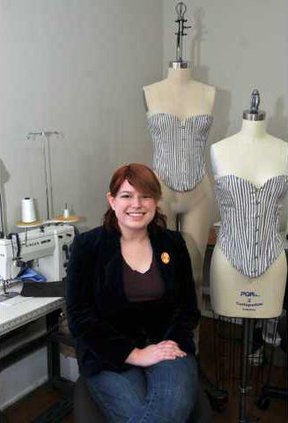In the upcoming Gainesville Theatre Alliance production, "Intimate Apparel," part of a two-play festival that opens Tuesday, the lead character Esther crafts corsets for women of different classes in 1905 Manhattan, yearning for something more than her solitary life.
Pulitzer Prize-winning playwright Lynn Nottage based the play loosely on the great-grandparents of African-American author Lynn Nottage.
Resident costumer and Brenau theater faculty member Fred Lloyd tapped Lizzy Trawick to design and construct the corsets for her senior thesis. The common threads woven through both her and Esther's experiences are overcoming obstacles, living through brokenness and receiving love from those around us.
Trawick is breaking new ground. Senior theses are usually done in GTA's student-produced Discovery Series, which is free to the public. In the past, a student could only sew costumes in a MainStage play, not design them. She was planning to sew costumes for the play until Lloyd asked her to concentrate on the corsets.
When she first came to Brenau, she wanted to major in theater education or directing, but settled instead on a newly created bachelor of fine arts degree in technical theater, with an emphasis on costume design and costume technology.
After a couple of costume classes with Lloyd, she was hooked, though her prior sewing experience was limited.
"He is amazing," Trawick said of Lloyd. "He is always helping us learn how to do things quicker and better."
Monday, the night before the festival opening, Trawick will welcome patrons to the play's preview and spotlight the organization To Write Love On Her Arms, which will benefit from proceeds from intermission sales. The nonprofit aims to give hope to people dealing with depression, addiction, self-abuse or suicide.
Trawick had a couple of friends in high school who cut themselves. "If I had known then that they were doing it, I would have helped them. This is a way I can help now."
In the play, Esther realizes how much her friends love her after her husband's betrayal. Trawick's sewing mimics the experience of Esther, and she clearly relishes the role.
"It is an absolutely beautiful play," she said. "It gets into the rawness of relationships. It is my favorite play I've ever read."
According to Trawick, "Esther sees in people what (the play's Orthodox Jewish fabric merchant) Marks sees in fabric. Both see possibilities and stories. Esther finds potential in him because of his kindness, and they become great friends and confidants."
Trawick believes that Esther designs the undergarments based on her perception of the one wearing them. She doesn't see her client, Mayme, as a prostitute, but as her confident, classical piano-playing best friend. For her, she makes a corset of rich silk, with beautiful trim.
Her high society client with marriage troubles asks for a daring corset that she has seen on the lower side of town. As Esther says, "They want what you got, and you want what they got."
She makes her own wedding corset based on her true opinion of herself. Later, in a bid to win back her husband's attention, she constructs a corset that reveals her darker side that wants to appear as someone she's not.
Trawick, who was born without a left hand, said her parents always taught her that she was different but it didn't mean she couldn't do something that she wanted to do. They provided access to prosthetic devices when she was 5 or 6, but they just got in the way. Her usual practice is to do try to something before asking for help. She doesn't anticipate needing help with the corset-making, except for the grommets.
She assembles the corsets by taking measurements from the actresses and translating them to a pattern she designs, all without using a form. It is quite a mathematical process. The skills most important for this job are speed and knowledge of advanced sewing techniques. The sewer also needs to be able to fudge these techniques in a time crunch because the audience sees the costume in the dark and far away.
Today's relaxed corsets are made to fit the figure and have plastic supports in the seams. Most corsets in 1905 were made in a fixed shape and had rigid stays made of steel or whalebone. They were sometimes cinched tightly to make a waist ideally between 17 and 23 inches.
In extreme tightlacing, the rib cage was crushed in, the internal organs rearranged and the figure was trained that way, similar to foot-binding in China. In certain kinds of corsets, the rib cage was thrust forward and the hips backward, causing back problems.
Trawick is making rehearsal corsets with steel stays to get the actors used to wearing them. She has used the book, "The Corset: A Cultural History" extensively.
Her resume will be finding its way to positions in major cities later this year when she graduates.

